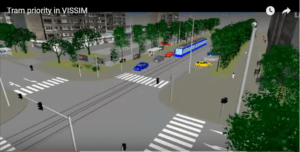[...]
1) Croydon Council as highway authority agreed to provide Tramlink with
tram priority at traffic signals. Please provide a list of junctions and
tram crossings where this applies.
Tram priority (or Light Rapid Transit mode – LRT) applies to all of the
traffic signal controlled junctions on the Tramlink network, see below
(including our traffic signal reference number before the site location):
-
LONDON BOROUGH OF CROYDON
20/006 - GEORGE STREET - PARK STREET - PARK LANE - WELLESLEY ROAD
20/008 - NORTH END ROAD - STATION ROAD -LONDON ROAD - TAMWORTH ROAD
20/036 - CAIRO NEW ROAD - TAMWORTH ROAD -CHURCH STREET
20/081 - A212-WELLESLEY ROAD - STATION ROAD
20/100 - WELLESLEY ROAD - POPLAR WALK
20/135 - GEORGE STREET - DINGWALL ROAD
20/213 - ADDISCOMBE RD - CHEPSTOW ROAD - CLYDE ROAD - RADCLIFFE ROAD
20/215 - ADDISCOMBE RD - ADDISCOMBE GROVE - CHERRY ORCHARD ROAD
20/217 - A212 WELLESLEY ROAD - LANSDOWNE ROAD
20/220 - CROWN HILL - FRITH ROAD - MIDDLE STREET
20/221 - GRAVEL HILL - COOMBE ROAD - TRAMWAY CROSSING
20/222 - OAKS ROAD - TRAMWAY CROSSING
20/223 - A212 GRAVEL HILL - ADDINGTON PALACE GOLF CLUB
20/224 - A2022 KENT GATE WAY - ADDINGTON PARK
20/225 - KENT GATE WAY - TRANSPORT INTERCHANGE (REPLACED 20/107)
20/226 - LODGE LANE - KING HENRYS ROUNDABOUT
20/227 - PARKWAY BY KING HENRYS ROUNDABOUT
20/229 - BINGHAM ROAD BY TRAMWAY CROSSING
20/230 - LOWER ADDISCOMBE ROAD BY TRAMWAY CROSSING
20/284 - TAMWORTH ROAD - FIRTH ROAD - CROYDON CENTRALE
LONDON BOROUGH OF MERTON
22/040 - KINGSTON ROAD - HARTFIELD ROAD - TRAMWAY CROSSING
22/168 - DUNDONALD ROAD - TRAMWAY CROSSING
LONDON BOROUGH OF SUTTON
21/107 - BEDDINGTON LANE - TRAMWAY CROSSING
2) In the case of road junctions where trams also cross, ie which are
more than merely a tram crossing of a road, please provide an explanation
of how tram priority works.
Tram priority works in a similar manner at each of the 23 junctions on the
Tramlink network. Inductive loop detectors are installed under the
tramway; the demand detector is situated at between 150m and 200m from the
junction. As a tram passes over it a demand is registered with the signal
controller to move as quickly as possible to a point in the signal
sequence where the tram receives a signal to proceed. A second detector
is situated at the tram stop line. As the tram passes over it the
priority demand is removed and the signals will move off the tram
‘proceed’ signal. A third detector is situated on the exit side of
the junction. As the tram passes over it the signals drop out of tram
mode (LRT) and move to service the next vehicle or pedestrian demands
around the junction.
All of the signal installations are demand dependent meaning that they
react to vehicle or pedestrian demand. It is not possible to give the
actual green running times for any phase at any junction as Vehicle
Actuation is a fully adaptive system and timings will change depending
upon traffic demand.
3) How is this system of tram priority prescribed, and how much can the
council reduce it in the interests of other road users?
Tram priority is prescribed by The Office of Rail Regulation document -
Railway Safety Publication 2
([1]
http://www.rail-reg.gov.uk/server/show/n.... The Highway
Authority (the Council) agreed at the time of implementation that trams
would get ultimate priority through a junction and therefore the LRT mode
of operation was introduced.
The Highway Authority may remove tram priority at any time, at any
junction, should it so desire with the agreement of Transport for London
and the tram operators.
4) In central Croydon, there are key tram road junctions at:
Addiscombe Road / Chepstow Road
Addiscombe Road / Cherry Orchard Road
Wellesley Road / George Street
Wellesley Road / Station Road
London Road / Station Road
Tamworth Road / Cairo New Road
For each of these junctions and associated signals, please provide a
diagram and listing showing the phases and times which apply, and how
these vary across the day and week. For example, Road 1 and time, Tram and
time, Road 2 and time etc.
The operation of these tram sites (defining phases and times) is
classified in the document referenced in section 3. In addition, as all
the sites run Vehicle Actuated timings, this means that the green time
varies every cycle depending on the volume of traffic waiting at the stop
lines. Based on these facts we are unable to supply the information in
the format that you have requested
5) What is the procedure to ensure that if a tram call comes, each road
gets a fair chance, and there are no long waits?
See explanation above. If a Tram arrives at a traffic signal site it will
get priority through the junction. The controller will then service the
other demands, but if another tram arrives at the junction this will also
trigger priority through the junction.
[...continues at length...]







